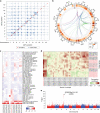Genome of Solanum pimpinellifolium provides insights into structural variants during tomato breeding
- PMID: 33199703
- PMCID: PMC7670462
- DOI: 10.1038/s41467-020-19682-0
Genome of Solanum pimpinellifolium provides insights into structural variants during tomato breeding
Abstract
Solanum pimpinellifolium (SP) is the wild progenitor of cultivated tomato. Because of its remarkable stress tolerance and intense flavor, SP has been used as an important germplasm donor in modern tomato breeding. Here, we present a high-quality chromosome-scale genome sequence of SP LA2093. Genome comparison identifies more than 92,000 structural variants (SVs) between LA2093 and the modern cultivar, Heinz 1706. Genotyping these SVs in ~600 representative tomato accessions identifies alleles under selection during tomato domestication, improvement and modern breeding, and discovers numerous SVs overlapping genes known to regulate important breeding traits such as fruit weight and lycopene content. Expression quantitative trait locus (eQTL) analysis detects hotspots harboring master regulators controlling important fruit quality traits, including cuticular wax accumulation and flavonoid biosynthesis, and SVs contributing to these complex regulatory networks. The LA2093 genome sequence and the identified SVs provide rich resources for future research and biodiversity-based breeding.
Conflict of interest statement
The authors declare no competing interests.
Figures




References
-
- Ebert, A. W. & Schafleitner, R. in Crop Wild Relatives and Climate Change, 141–172 (John Wiley & Sons, Inc Hoboken, NJ, USA, 2015).
Publication types
MeSH terms
Substances
Associated data
LinkOut - more resources
Full Text Sources
Other Literature Sources

